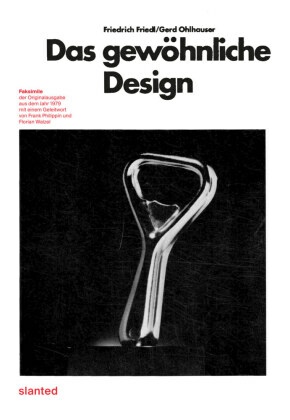
Das gewöhnliche Design - Faksimile der Originalausgabe von 1979
| Verlag | Slanted Publishers |
| Auflage | 2023 |
| Seiten | 104 |
| Format | 15,1 x 0,8 x 22,3 cm |
| Gewicht | 264 g |
| ISBN-10 | 3948440484 |
| ISBN-13 | 9783948440480 |
| Bestell-Nr | 94844048A |
Neu herausgegeben von Frank Philippin und Florian Walzel legt Slanted das Faksimile "Das gewöhnliche Design" wieder auf. Damit wird nicht nur ein Designklassiker zugänglich gemacht, sondern auch die Frage neu gestellt: Wie viel Design ist dem Gewöhnlichen geschuldet? In einer Zeit, die ihre kulturelle Aufmerksamkeit fast ausschließlich dem Neuen und Außergewöhnlichen widmet, ist der alltägliche Gebrauchsgegenstand der stiller Gegner von "Design".
"Das gewöhnliche Design" ist ein heimlicher Klassiker der deutschen Designgeschichte, den man in der Vinyl-Ära wohl als B-Side Hit bezeichnet hätte. Bereits 1976 stellte eine Gruppe von Studenten und jungen Professoren am Fachbereich Gestaltung der Fachhochschule Darmstadt die Art und Weise in Frage, wie Designobjekte allgemein wahrgenommen, besprochen und beschrieben wurden. Frustriert vom Gegensatz zwischen ihrem Selbstverständnis als umfassende Entwerfer und der Aussicht auf eine spätere Karriere als bloße Product Stylists suchten sie nach einem alternativen Verständnis dessen, was gutes Design ausmacht. Angeführt von Friedrich Friedl und Gerd Ohlhauser begann die Gruppe gewöhnliche Dinge, wie Flaschenöffner, Luftpumpen oder Busfahrpläne, zu sammeln. Diese Objekte, alle von anonymen Autoren, wurden am eigenen Fachbereich unter dem Titel "Das gewöhnliche Design" ausgestellt. Diese Schau, die ausschließlich "langweilige" Alltagsgegenstände präsentierte, fand bundesweite Beachtung und sorgte für Diskussionen in der Designpresse. Auf ironische Weise hatten die jungen Designer traditionelle Ausstellungsmittel wie mit Samt bezogene Podeste benutzt, die normalerweise der "hohen Kunst" vorbehalten waren. Zusammen mit den unspektakulären Exponaten provozierte dies das Publikum oder irritierte zumindest. Das Fehlen von heroischen, ikonischen oder ästhetisch verfeinerten Qualitäten unter den gezeigten Dingen schien gleichzeitig die gesamte Designausbildung zu verspotten. Der Ansatz war so originell, dass das Rheinische Freilicht- und Landesmuseum Kommern die ungewöhnlich gewöhnlichen Exponate ankaufte, die Ausstellung wiederholte und einen Ausstellungskatalog druckte. Der 104 Seiten starke Katalog enthielt unter anderem Beiträge von Bazon Brock, Peter von Kornatzki und Adelhart Zippelius. Die 110 schwarz-weiß Fotografien geben eine spezifische Momentaufnahme ab, was Mitte der 70er Jahre eine unspektakuläre Produktnormalität bedeutete.Obwohl dies als eine der frühe sten Versuche angesehen werden muss, die Würdigung profaner Qualitäten im Designdiskurs zu verankern, wurde der Katalog zur Rarität und ist heute nur noch in wenigen Bibliotheken einsehbar. Neu herausgegeben von Frank Philippin und Florian Walzel legt Slanted das Faksimile "Das gewöhnliche Design" wieder auf. Damit wird nicht nur ein Designklassiker zugänglich gemacht, sondern auch die Frage neu gestellt: Wie viel Design ist dem Gewöhnlichen geschuldet? In einer Zeit, die ihre kulturelle Aufmerksamkeit fast ausschließlich dem Neuen und Außergewöhnlichen widmet, ist der alltägliche Gebrauchsgegenstand der stiller Gegner von "Design".
Newly edited by Frank Philippin and Florian Walzel, the facsimile "Das gewöhnliche Design" presented by Slanted returns the work to a wider audience. More than just making a design classic available again this renews the question: How much of design is owed to the ordinary? In a time that dedicates its cultural attention almost exclusively to novelty and exceptionalism the every day utility is the silent opponent of "design".
